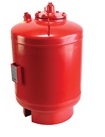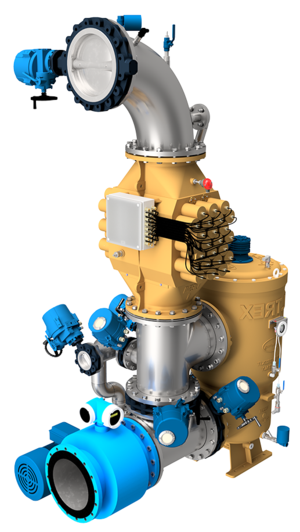
Pumps and Pumping Solutions
A pump is a device that moves fluids like liquids or gases, sometimes even slurries, by mechanical action typically converted from electrical energy into hydraulic energy. Pumps operate through a rotary or reciprocating mechanism that requires mechanical energy to move the fluid under consideration. Today there are various types of pumps and pumping solutions. However, centrifugal pumps are considered the most common type in the industry. They are compactly designed anti-corrosion pumps that are easy to operate and maintain. We offer a wide range of pumps and pumping solutions for marine & offshore, industry, defense & fuel, utility, and environmental equipment for oil spills, seaweed, and clean waterways.
HVH Industrial works with the specialized engineering teams of manufacturers to meet the requirements and highest quality standards of our customers.
If you have any questions, write us via live chat, (one of our team members will answer your questions), give us a call, or send us a quote request. The HVH team is always ready to help you.
 1(866)577-4040
1(866)577-4040
or
Pumps & Pumping Solutions
Manufacturers
What is a Pump
A pump is a device that converts mechanical forces and movements into hydraulic fluid power, which means that a pump moves fluids such as gases and liquids through mechanical action. The pump is the heart of a hydraulic system, and it is driven by an electric motor or a combustion engine. To move a fluid from one place to another, a pump operates by a rotary or reciprocation mechanism. Pumps vary in size from big industrial pumps to microscopic pumps used in medical applications. The four main types of pumps are gear pumps, vane pumps, piston pumps, and centrifugal pumps.
Types of Pumps
Gear Pumps
Gear pumps are compact and inexpensive and consist of moving gears. Two types of gear pumps are available: gear-on-gear and gear-within-gear. A gear on the gear pump consists of two gears of the same size that engage with each other. The driving gear, which is connected to the drive shaft, moves the second gear. As the gears move, water is drawn and delivered to the discharge port. Helical and spur gears are both used in gear-on-gear pumps. In comparison, a gear-within-gear pump consists of an external gear and a smaller internal gear. The inner gear has one tooth less than the outer gear. The internal gear pump is a rotary positive displacement pump that moves fluid using the rotary motion of the pumping elements. The main advantage of a gear pump is that it doesn’t have a BEP or best efficiency point; it is consistently efficient. Another advantage is that the gear pump doesn’t have to generate centrifugal force; it can run at a much lower speed, making it smoother and more controllable.

External Gear Pump by Marzocchi

Internal Gear Pump by Desmi
Vane Pumps
Vane pumps consist of a circular rotor mounted in a circular cavity. When the rotor turns, the vanes in the pump extend and retract to lock the cavity surface. The fluid is confined in the inlet; then, it is swept by the vanes and pushed through the outlet. Vane pumps are most efficient at speeds over 600 rpm. At lower speeds, the efficiency decreases as the leakage is high. As the vane pump is subject to high bearing, the best design is to place the two inlets and two outlet ports opposite each other and place the rotor in the center. Main advantages of vane pumps: handling viscous fluids up to 10,000cst, high suction lift capability, constant flow with varying pressure, and self-compensation for wear as vane tips wear they extend further out of the rotor.

Vane Pump
Piston Pumps
Piston pumps are the most efficient and complex designed pumps but are also the most expensive. Piston pumps have a volumetric efficiency of up to 99 percent. Piston pumps convert the rotary motion of an input shaft to a reciprocating motion of pistons. The fluid is drawn into the chamber and then forced out by the piston. The valves control the flowing direction. Axial and radial are two types of piston pumps. The name of each pump indicates the direction of piston movement with respect to the pump shaft. The main advantages of a piston pump are a continuous rate of discharge, long performance life if properly maintained, high-pressure control without affecting the flow rate, and efficiency.

Piston Pump
Centrifugal Pumps
Centrifugal pumps move liquids from one point to another by raising their pressure. Centrifugal pumps are designed with curved vanes, which rotate when submerged in the liquid required to be pumped. The water is forced out through the exit by a centrifugal force from the rotating vanes. If air gets into the pump, it cannot force water out. Therefore centrifugal pumps only operate when submerged. Centrifugal pumps are the most common pumps because they are not expensive and easy to operate. The main advantages of centrifugal pumps are smooth flow, low infrastructure cost, versatility, efficiency, and easy maintenance. In contrast, the main disadvantages of centrifugal pumps are inaccurate flow, limited viscosity handling, and shearing.

Centrifugal Pump by Desmi
Factors to Consider when Choosing a Pump
The most important factors to consider when choosing a pump are pressure, flow, speed, and efficiency. Pressure affects the pump directly, if the pressure is too high for the pump to withstand, it can cause internal leakage and damage to pump parts. Flow is how much fluid a pump can deliver and is usually in cubic inches per revolution. Speed is a dimensionless number that describes the characteristics of an impeller. Finally, efficiency can be volumetric, overall, and mechanical. Volumetric efficiency is the ratio of actual to theoretical delivery, overall efficiency is the ratio of hydraulic power output to mechanical power input, and mechanical efficiency is the ratio of actual pressure to theoretical pressure.




















